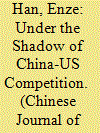| Srl | Item |
| 1 |
ID:
177304


|
|
|
|
|
| Summary/Abstract |
The American factor has become the biggest external variable in the growth of China-Japanrelations. The COVID-19 pandemic is still raging across the globe, accelerating the changes that are unseen in a century. A salient feature of the global landscape is the intensifying competition between China and the US, which is shaping in a profound way the prospects ofChina-Japanrelations.The changes of administration in Japan and the US in 2020 add to the uncertainties in China-Japan relations. In the face ofcrises and opportunities in the fluid global dynamics, China and Japan should act proactively and meet each other halfway to create conditions for cooperation, expand common interests, and enlargethe space for cooperation so as to develop their relations in line with the requirements of the new era.
|
|
|
|
|
|
|
|
|
|
|
|
|
|
|
|
| 2 |
ID:
158259


|
|
|
|
|
| Summary/Abstract |
With the U.S. and China competing for influence in Southeast Asia, how secondary states in the region make their foreign policy choices has come under more scrutiny. It seems secondary states in the region have exerted strong will and capacity to maintain significant amount of freedom in choosing their foreign policy orientations, rather than being totally dictated by the great powers. This paper presents a detailed paired comparison of Myanmar and Thailand’s alignment policies and their consequences since the end of World War II. The paper argues that international structural factors certainly constrain the options for secondary states, but domestic politics often play a significant role in how political leaders make the alignment choices they do, which is heavily conditioned by how these leaders derive their political legitimacy. Thus, to explain the alignment choices of secondary states in Southeast Asia, we need to pay more attention to the intertwined nature between domestic political contestation and foreign policy making.
|
|
|
|
|
|
|
|
|
|
|
|
|
|
|
|